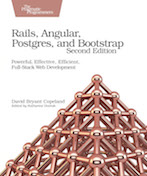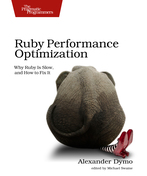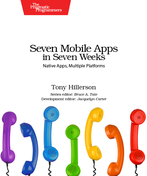Agile Web Development with Rails, Edition 4
12.2 Iteration G2: Atom Feeds
11.5 Iteration F5: Making Images Clickable
12.1 Iteration G1: Capturing an Order
Create a model to contain orders
rails generate scaffold Order name address:text email pay_type invoke active_record
create db/migrate/20160613194111_create_orders.rb
create app/models/order.rb
invoke test_unit
create test/models/order_test.rb
create test/fixtures/orders.yml
invoke resource_route
route resources :orders
invoke scaffold_controller
create app/controllers/orders_controller.rb
invoke erb
create app/views/orders
create app/views/orders/index.html.erb
create app/views/orders/edit.html.erb
create app/views/orders/show.html.erb
create app/views/orders/new.html.erb
create app/views/orders/_form.html.erb
invoke test_unit
create test/controllers/orders_controller_test.rb
invoke helper
create app/helpers/orders_helper.rb
invoke test_unit
create test/helpers/orders_helper_test.rb
invoke jbuilder
create app/views/orders/index.json.jbuilder
create app/views/orders/show.json.jbuilder
invoke assets
invoke coffee
create app/assets/javascripts/orders.js.coffee
invoke scss
create app/assets/stylesheets/orders.css.scss
invoke scss
identical app/assets/stylesheets/scaffolds.css.scss
Create a migration to add an order_id column to line_items
rails generate migration add_order_id_to_line_item order_id:integer invoke active_record
create db/migrate/20160613194112_add_order_id_to_line_item.rb
Apply both migrations
rake db:migrate mv 20160613194111_create_orders.rb 20160613000007_create_orders.rb
mv 20160613194112_add_order_id_to_line_item.rb 20160613000008_add_order_id_to_line_item.rb
== 20160613000007 CreateOrders: migrating =====================================
-- create_table(:orders)
-> 0.0024s
== 20160613000007 CreateOrders: migrated (0.0024s) ============================
== 20160613000008 AddOrderIdToLineItem: migrating =============================
-- add_column(:line_items, :order_id, :integer)
-> 0.0004s
== 20160613000008 AddOrderIdToLineItem: migrated (0.0004s) ====================
Add a Checkout button to the cart
edit app/views/carts/_cart.html.erb <p id="notice"><%= notice %></p>
<h2>Your Cart</h2>
<table>
<%= render(cart.line_items) %>
<tr class="total_line">
<td colspan="2">Total</td>
<td class="total_cell"><%= number_to_currency(cart.total_price) %></td>
</tr>
</table>
<%= button_to "Checkout", new_order_path, method: :get %>
<%= button_to 'Empty cart', cart, method: :delete,
data: { confirm: 'Are you sure?' } %>
Return a notice when checking out an empty cart
edit app/controllers/orders_controller.rb class OrdersController < ApplicationController
include CurrentCart
before_action :set_cart, only: [:new, :create]
before_action :ensure_cart_isnt_empty, only: :new
before_action :set_order, only: [:show, :edit, :update, :destroy]
# GET /orders
#...
private
def ensure_cart_isnt_empty
if @cart.line_items.empty?
redirect_to store_index_url, notice: 'Your cart is empty'
end
end
end
Modify tests to ensure that there is an item in the cart
edit test/controllers/orders_controller_test.rb test "requires item in cart" do
get :new
assert_redirected_to store_index_path
assert_equal flash[:notice], 'Your cart is empty'
end
test "should get new" do
item = LineItem.new
item.build_cart
item.product = products(:ruby)
item.save!
session[:cart_id] = item.cart.id
get :new
assert_response :success
end
Modify the template for new orders
edit app/views/orders/new.html.erb <div class="depot_form">
<fieldset>
<legend>Please Enter Your Details</legend>
<%= render 'form', order: @order %>
</fieldset>
</div>
Add payment types to the order
edit app/models/order.rb class Order < ActiveRecord::Base
PAYMENT_TYPES = [ "Check", "Credit card", "Purchase order" ]
end
Modify the partial used by the template
edit app/views/orders/_form.html.erb <%= form_for(@order) do |f| %>
<% if @order.errors.any? %>
<div id="error_explanation">
<h2><%= pluralize(@order.errors.count, "error") %>
prohibited this order from being saved:</h2>
<ul>
<% @order.errors.full_messages.each do |msg| %>
<li><%= msg %></li>
<% end %>
</ul>
</div>
<% end %>
<div class="field">
<%= f.label :name %><br>
<%= f.text_field :name, size: 40 %>
</div>
<div class="field">
<%= f.label :address %><br>
<%= f.text_area :address, rows: 3, cols: 40 %>
</div>
<div class="field">
<%= f.label :email %><br>
<%= f.email_field :email, size: 40 %>
</div>
<div class="field">
<%= f.label :pay_type %><br>
<%= f.select :pay_type, Order::PAYMENT_TYPES,
prompt: 'Select a payment method' %>
</div>
<div class="actions">
<%= f.submit 'Place Order' %>
</div>
<% end %>
Add some CSS
edit app/assets/stylesheets/application.css.scss .depot_form {
fieldset {
background: #efe;
legend {
color: #dfd;
background: #141;
font-family: sans-serif;
padding: 0.2em 1em;
}
div {
margin-bottom: 0.3em;
}
}
form {
label {
width: 5em;
float: left;
text-align: right;
padding-top: 0.2em;
margin-right: 0.1em;
display: block;
}
select, textarea, input {
margin-left: 0.5em;
}
.submit {
margin-left: 4em;
}
br {
display: none
}
}
}
Validate that required fields are present
edit app/models/order.rb class Order < ActiveRecord::Base
# ...
validates :name, :address, :email, presence: true
validates :pay_type, inclusion: PAYMENT_TYPES
end
Update the test data in the orders fixture
edit test/fixtures/orders.yml # Read about fixtures at
# http://api.rubyonrails.org/classes/ActiveRecord/FixtureSet.html
one:
name: Dave Thomas
address: MyText
email: dave@example.org
pay_type: Check
two:
name: MyString
address: MyText
email: MyString
pay_type: MyString
Move a line item from a cart to an order
edit test/fixtures/line_items.yml # Read about fixtures at
# http://api.rubyonrails.org/classes/ActiveRecord/FixtureSet.html
one:
product: two
cart: one
two:
product: ruby
order: one
Define an optional relationship from the line item to the order
edit app/models/line_item.rb class LineItem < ActiveRecord::Base
belongs_to :order
belongs_to :product
belongs_to :cart
def total_price
product.price * quantity
end
end
Define a relationship from the order to the line item
edit app/models/order.rb class Order < ActiveRecord::Base
has_many :line_items, dependent: :destroy
# ...
end
Add line item to order, destroy cart, and redisplay catalog page
edit app/controllers/orders_controller.rb def create
@order = Order.new(order_params)
@order.add_line_items_from_cart(@cart)
respond_to do |format|
if @order.save
Cart.destroy(session[:cart_id])
session[:cart_id] = nil
format.html { redirect_to store_index_url, notice:
'Thank you for your order.' }
format.json { render action: 'show', status: :created,
location: @order }
else
format.html { render action: 'new' }
format.json { render json: @order.errors,
status: :unprocessable_entity }
end
end
end
Implement add_line_items_from_cart
edit app/models/order.rb class Order < ActiveRecord::Base
# ...
def add_line_items_from_cart(cart)
cart.line_items.each do |item|
item.cart_id = nil
line_items << item
end
end
end
Modify the test to reflect the new redirect
edit test/controllers/orders_controller_test.rb test "should create order" do
assert_difference('Order.count') do
post :create, order: { address: @order.address,
email: @order.email, name: @order.name,
pay_type: @order.pay_type }
end
assert_redirected_to store_index_path
end
take a look at the validation errors
get /orders/new
Your Cart
1×
Rails, Angular, Postgres, and Bootstrap
$45.00
Total
$45.00
post /orders
process an order
get /orders/new
post /orders
order[name] => Dave Thomas
order[address] => 123 Main St
order[email] => customer@example.com
order[pay_type] => Check
You are being
redirected .
get http://localhost:3000/store/index
Thank you for your order.
Your Pragmatic Catalog
Rails, Angular, Postgres, and Bootstrap
Powerful, Effective, and Efficient Full-Stack Web Development
As a Rails developer, you care about user experience and performance,
but you also want simple and maintainable code. Achieve all that by
embracing the full stack of web development, from styling with
Bootstrap, building an interactive user interface with AngularJS, to
storing data quickly and reliably in PostgreSQL. Take a holistic view of
full-stack development to create usable, high-performing applications,
and learn to use these technologies effectively in a Ruby on Rails
environment.
Ruby Performance Optimization
Why Ruby Is Slow, and How to Fix It
You don’t have to accept slow Ruby or Rails performance. In this
comprehensive guide to Ruby optimization, you’ll learn how to write
faster Ruby code—but that’s just the beginning. See exactly what makes
Ruby and Rails code slow, and how to fix it. Alex Dymo will guide you
through perils of memory and CPU optimization, profiling, measuring,
performance testing, garbage collection, and tuning. You’ll find that
all those “hard” things aren’t so difficult after all, and your code
will run orders of magnitude faster.
Seven Mobile Apps in Seven Weeks
Native Apps, Multiple Platforms
Answer the question “Can we build this for ALL the devices?” with a
resounding YES. This book will help you get there with a real-world
introduction to seven platforms, whether you’re new to mobile or an
experienced developer needing to expand your options. Plus, you’ll find
out which cross-platform solution makes the most sense for your needs.
look at the underlying database
sqlite3> select * from orders id = 1
name = Dave Thomas
address = 123 Main St
email = customer@example.com
pay_type = Check
created_at = 2016-06-13 19:41:13.391569
updated_at = 2016-06-13 19:41:13.391569
sqlite3> select * from line_items id = 10
product_id = 2
cart_id =
created_at = 2016-06-13 19:41:08.367016
updated_at = 2016-06-13 19:41:13.393457
quantity = 1
price = 45
order_id = 1
hide the notice when adding items to the cart
edit app/views/line_items/create.js.erb $('#notice').hide();
if ($('#cart tr').length == 1) { $('#cart').show('blind', 1000); }
$('#cart').html("<%=j render(@cart) %>");
$('#current_item').css({'background-color':'#88ff88'}).
animate({'background-color':'#114411'}, 1000);
12.2 Iteration G2: Atom Feeds
11.5 Iteration F5: Making Images Clickable


